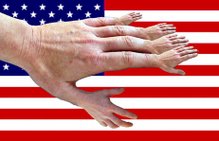
"Not square feet."
Hardwood flooring, that is. When I had my flooring company, I ran into a few suppliers who gave me this line. Now, a board-foot is defined in the dictionary as lumber measuring one square foot one inch thick. But what it doesn't say is that's un-dried. After it is dried it shrinks, and after it shrinks it loses more volume in the milling process. Pine shrinks more than hardwood.
An actual board-foot of dried hardwood flooring which is ¾" thick, the standard, yields by the dictionary definition 1.33333 square feet of flooring. But, as I said, it is what the product is milled from initially that the supplier is defining. In this case, it is fresh moist wood blanks measuring 1" thick x 3" wide. (To become standard 2¼" strip flooring.) Which means you should measure the square feet of the room(s), figure how much you will have to scrap, (about 5% works), and then, instead of multiplying by .75, divide by it. Or to put it another way, instead of dividing by 1⅓, multiply by it.
Confused? Who wouldn't be?
Now I'm good with a calculator, better than most, but this is about one of the most confusing things I've come across. And I even understand it. But I often had to call in my orders at the end of a very long exhausting day. One of the joys of management.
I told my regular supplier I wanted his computer-printed invoices to print square feet on them and that I would be ordering by square feet. I told him fatigue was often a factor and I was a customer so customer service demanded we would be playing my game, not his. So he did it. (Easily, by the way.)
Several other suppliers tried this with me. I told my second-most steady supplier the same, and he complied: he used to install flooring himself before he went into sales and knew exactly where I was coming from.
I tried this on a third vendor I was trying to work with, and they refused! "We supply it in board-feet."
I pulled my tape measure from my belt and said "See this? It's marked in feet and inches, and when I measure a floor, I come up with square feet. There are no board-feet on this tape." They refused to convert any orders routinely for me, so I said goodbye and left.
. . .
My theory is that many vendors benefit from this confusion, especially when selling to homeowners and innumerate carpenters and builders. Plus, guys want to be in the select fraternity of lumber guys who know what board-feet are. If they don't, they will fake it. The chances are high that they will order incorrectly, and either buy too much (plus an extra factor for scrap which the salesman, sensing blood in the water, will always remind the customer about! Usually recommending 10 -20% extra on top of that!) or, the customer will err the other way and run out of wood before the job is done, and order more, giving the salesman another chance to run his routine, and maybe do it again!In the process, the customer, if a tradesman, runs the risk of angering the homeowner or contractor because of the delay, about which the salesmen who practice this lucrative humbuggery don't care.
Not only that, leftover hardwood usually gets stored somewhere humid, swelling it up and making it unsuitable for installation in climate-controlled homes and buildings, because it will shrink back to more stable dimensions eventually, leaving gaps between the boards. Eventually that finds its circuitous way back to the unwary contractor or homeowner, who again will suffer.
I see all this madness as an arena. An arena in which two great forces battle for the soul of American Capitalism: one side sees their way as the American way: screwing the customer, they say, is as American as apple pie. The other side, the one I'm on, says you succeed by offering the best product and service you can provide.
How's my side doing?




No comments:
Post a Comment